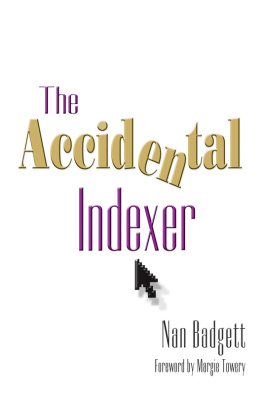
Second printing, 2004
The Accidental Webmaster
Copyright 2003 by Julie M. Still
All rights reserved. No part of this book may be reproduced in any form or by any electronic or mechanical means, including information storage and retrieval systems, without permission in writing from the publisher, except by a reviewer, who may quote brief passages in a review. Published by Information Today, Inc., 143 Old Marlton Pike, Medford, New Jersey 08055.
Publishers Note: The author and publisher have taken care in preparation of this book but make no expressed or implied warranty of any kind and assume no responsibility for errors or omissions. No liability is assumed for incidental or consequential damages in connection with or arising out of the use of the information or programs contained herein.
Many of the designations used by manufacturers and sellers to distinguish their products are claimed as trademarks. Where those designations appear in this book and Information Today, Inc. was aware of a trademark claim, the designations have been printed with initial capital letters.
Library of Congress Cataloging-in-Publication Data
Still, Julie.
The accidental webmaster / Julie M. Still.
p. cm.
Includes bibliographical references and index.
ISBN 1-57387-164-8
1. Web sites--Design. 2. Webmasters. I. Title.
TK5105.888.S744 2003
005.72dc21
2003001233
Printed and bound in the United States of America
Publisher: Thomas H. Hogan, Sr.
Editor-in-Chief: John B. Bryans
Managing Editor: Deborah R. Poulson
Copy Editor: Dorothy Pike
Graphics Department Director: M. Heide Dengler
Book Designer: Kara Mia Jalkowski
Cover Designer: Ashlee Caruolo
Indexer: Enid Zafran
Like all books this one has an individuals name on the spine but is actually the product of many peoples efforts. My thanks go out to all those who answered questions, let me interview them, listened to my insecurities and doubts, and provided comfort, assistance, a kick in the pants, and chocolate. My colleagues at the Paul Robeson Library, Rutgers University, Camden, were a wonderful support system. My family was patient with my long hours at the PC and on the phone and did not complain about the picnic dinners on the living room floor when the dining room table was buried in paper. All the wonderful folks at Abington Trails were gracious enough to let me put in stories and anecdotes. Lora, Gabrielle, Beth, Ed, Sy, John, and a host of others let me pick their brains on accidental Webmaster issues. John and Deborah at Information Today, Inc. did a great job of keeping me on track, something I need and truly appreciate. Thanks to one and all.
Julie M. Still
There are any number of books for sale on the technical aspects of setting up and running a Web site. This isnt one of them. Some of those books talk about setting up Web communities for hundreds and thousands of people. Others, like Webmastering for Dummies, describe how to set up Web sites at a cost of up to half a million dollars. This book is for people at the other end of the spectrum. It is intended for people who find themselves, whether intentionally or not, running a Web site for their sons Boy Scout troop, the local PTA, their church, book club, writers group, trails club, or Aunt Minnies suddenly, unbelievably popular line of homemade teddy bears. It is for people who are running a Web site as a volunteer (laughably low salaries for small local nonprofit groups and the pittance your neighbor pays you to run a site for his business dont count).
Setting up a static site, something created and never touched again, doesnt count. This book is intended for people who wind up designing and managing dynamic sites for active organizations and businesses. It is also assumed that accidental Webmasters dont exist in a vacuum but, for the most part, know or regularly contact other people in the organization or group.
In these cases, the technical aspects are often the least of your worries. In a work setting there are political pitfalls and hardware and software glitches as well as other difficulties, to be sure, but the volunteer Webmaster faces additional types of problems. That is what this book is intended to cover. Some technical skills are necessary, and you are likely to have the basics already or you wouldnt have found yourself in this situation. Some aspects of the technical side will be discussed, but primarily to bring up issues for thought or possible consequence. The problems inherent in setting up pricey business Web sites may be similar to the problems in setting up a Web site for a school board candidate, but other problems arise that are unique to the smaller situation.
After reading this book, you will have a much better idea of whether you want to take on this task (if it isnt already too late) and how to go about it. You may also need technical manuals, although with todays editors most people with basic computer literacy can put together a simple site in a relatively short period of time. However, as a theme of this book, putting together the Web site is a very small piece of the iceberg. As with houses, buying one may seem daunting, but the maintenance is even more time-consuming. Being informed of and prepared for what is involved in being an accidental Webmaster will enable you to leap the hurdles more quickly and savor the pleasures more frequently. Some Web sites are only up for a short period of time (organizations and businesses fold and campaigns end); others are likely to exist for decades. I have been an accidental Webmaster in a variety of contexts for a few years now. The example I will use most frequently in this book is the work I have done with Abington Trails, a community trails group. It has been immensely satisfying and I wish you a similarly enjoyable time.
In the course of my Web work and in writing this book, I have read many books and articles and interviewed a number of people who are similarly involved in Web site maintenance. At the end of each chapter you will find a brief list of published writings that may provide further information. The list of further readings is cumulated in a larger bibliography at the end of the book. Very few Web sites are referenced and few examples of small and local Web sites are given because the environment tends to be very fluid. What is presently a wonderful thriving example of an accidental Webmasters work may be defunct by the time you read this. Plenty of books out there provide examples of attractive and nicely designed sites, and I encourage you to take a look at them just to see what the possibilities are. (Tip: Save a few bucks and use copies at your local public library.)
The information herein is designed to help you sidestep problems and dissolve conflicts before they arise. Chances are you want your term as an accidental Webmaster to be an enjoyable one (since it isnt likely to be profitable). This book is in two parts. The first part is in chapters and covers basic concepts relating to accidental Webmastering in general. Following that are sections on specific types of Web sites maintained by accidental Webmasters.
Each reader will find different chapters and sections of greater interest. Those still deciding whether to become an accidental Webmaster will focus on the first few chapters as well as the section devoted to the type of site they are considering. Someone taking over an existing site will be more interested in the chapters on content and maintenance. The themes that appear in several places are probably the issues that accidental Webmasters deal with the most. Keep things simple. Update frequently. People skim text on the Web instead of reading it. Dont let yourself be overburdened (it isnt good for the group or business and it isnt good for you either). And when in doubt, dont do it.








